Link building remains one of Google’s top ranking factors. But success depends not just on acquiring links, but on earning them from the right websites. In this guide, I’ll share advanced link prospecting strategies, complete with practical workflows and tool recommendations that most marketers don’t talk about. Are you ready to transform your link building efforts?
What Is Link Prospecting?
Link prospecting is simply the process of finding websites that could link to your content, but how you do it makes all the difference.
For years, marketers have repeated the mantra:
“The higher the Domain Rating (DR), the better the backlink.”
On paper, that makes sense. In practice, a high-DR site with no topical relevance or traffic is mostly a vanity metric.
I’ve seen it time and again: a link from a smaller, highly relevant site can drive qualified visitors and deliver a stronger ranking boost than ten generic “authority” links combined.
Finding the right sites can feel tricky, but with the right approach, it becomes systematic. Let’s dive in.
5 Advanced Link Prospecting Strategies to Boost SEO
Here are five link prospecting strategies to improve your SEO rankings and streamline your backlink outreach.
1. Identify high-value prospects with competitor gap analysis
One of the fastest ways to find valuable link opportunities is by looking at who’s already linking to your competitors. If multiple competitors have backlinks from the same site, and you don’t, that’s a strong signal that the site is worth targeting.
Start by plugging competitor domains into tools like Ahrefs’ Link Intersect or Semrush’s Backlink Gap.
For example, we’re currently working with a client who is an online safety training provider. We analyzed competitors like OSHA.com to identify sites linking to them that weren’t linking to our client.
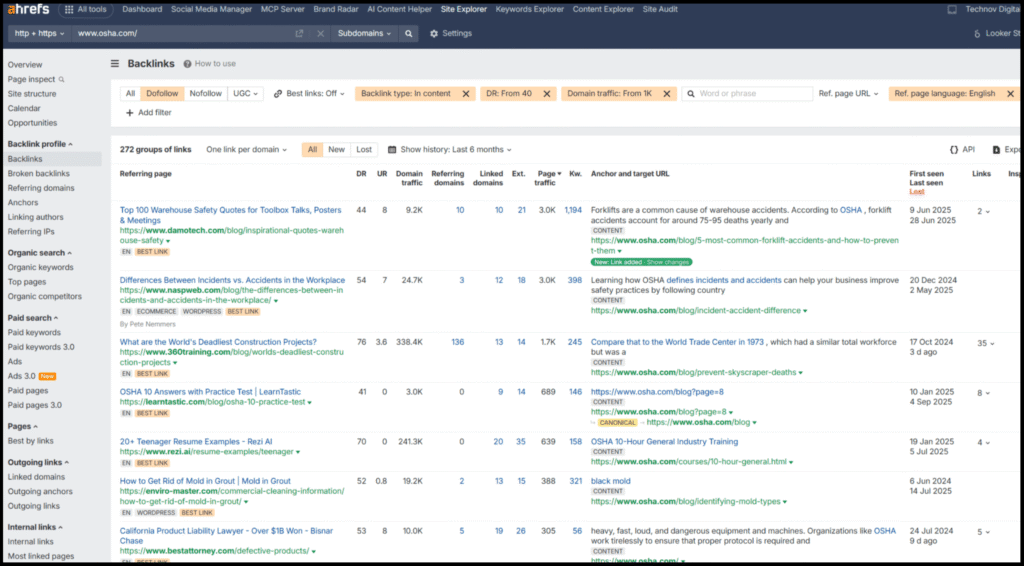
Using competitor gap analysis backlink approach
Next, we applied filters to narrow the list:
- Dofollow links only
- Minimum traffic – 1K+
- Language relevance – We have chosen English here
- Backlink type – In content is preferred
This approach helped us build a targeted list of warm prospects. Sites that link to more than one competitor are especially high-probability targets, so prioritize these first.
| 💡Pro-tip: Competitor gap analysis shows you where the low-hanging fruit is and saves you time chasing links that are unlikely to convert. This method reduces wasted effort and increases the chances of securing high-quality backlinks. |
2. Find easy wins with unlinked mentions & image reuse
Sometimes, the easiest link opportunities are right under your nose. Your brand, content, or visual assets may already be mentioned or used online, but without proper credit.
These are low-effort, high-return opportunities that can boost your SEO and drive traffic.
2.1 Finding unlinked mentions
Start by tracking where your brand or content is mentioned but not linked. Tools like Google Alerts and Ahrefs Content Explorer make this easy:
- Google Alerts: Go to google.com/alerts and set up alerts for your brand name, product names, or key content pieces. You’ll get notified whenever a new mention appears online.
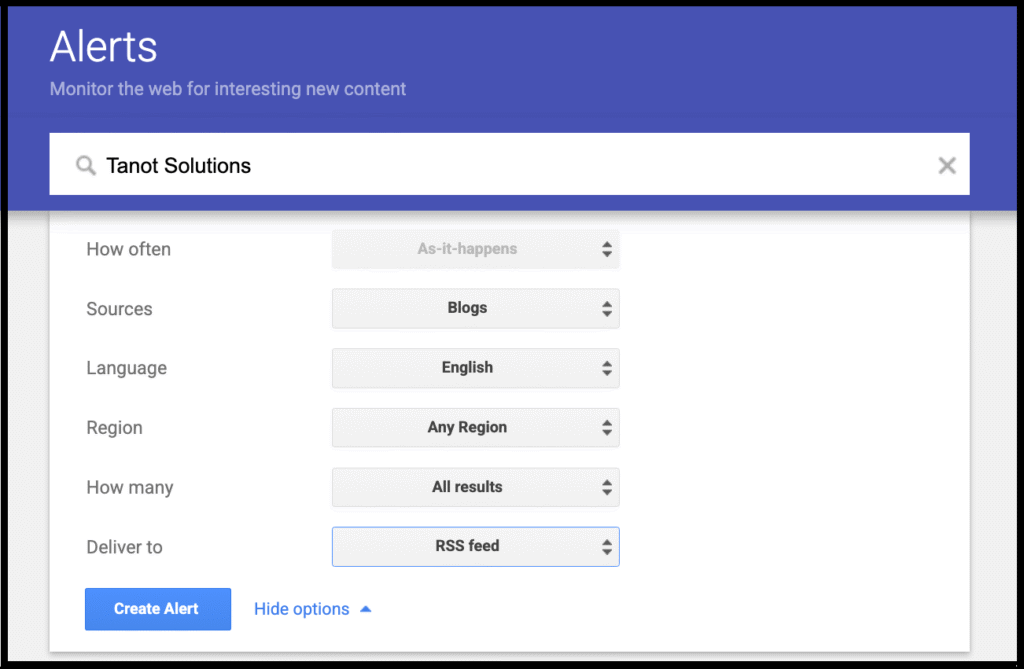
Use Google Alerts to find contextual link sources
- Ahrefs Content Explorer: Search for your brand or content, filter for unlinked mentions, and prioritize sites that have strong relevance or traffic.
According to Ahrefs, branded anchors show the strongest correlation (0.527) with search and AI visibility. This makes unlinked brand mentions a high-impact strategy for link building.
2.2 Finding image reuse opportunities
Visual assets, such as infographics, charts, or product images, are often used by other sites without attribution. You can turn this into a link building opportunity by:
- Running a Google Reverse Image Search or using TinEye to see where your images appear online.
- Reaching out with a polite note, asking the site to credit you with a link back to your website.
| 💡Pro-tip: Links from unlinked mentions and image reuse are among the easiest to secure because the publisher is already referencing your brand or content. They just need a little nudge to give proper credit. |
3. Explore topical adjacencies (beyond keywords)
Most agencies only prospect within obvious niches. The smarter play is to explore topical adjacency—sites that may not be your core niche but are contextually related.
This strategy uncovers valuable link opportunities that your competitors might overlook.
3.1 Using ChatGPT for topical expansion
ChatGPT can be a powerful tool to identify adjacent niches and related queries.
For example, when working with a client in the online safety training space, we used ChatGPT to reveal relevant adjacent queries. We started with a well-crafted prompt asking it to identify additional niches and related topics that could uncover new link building prospects.
Here’s the prompt:
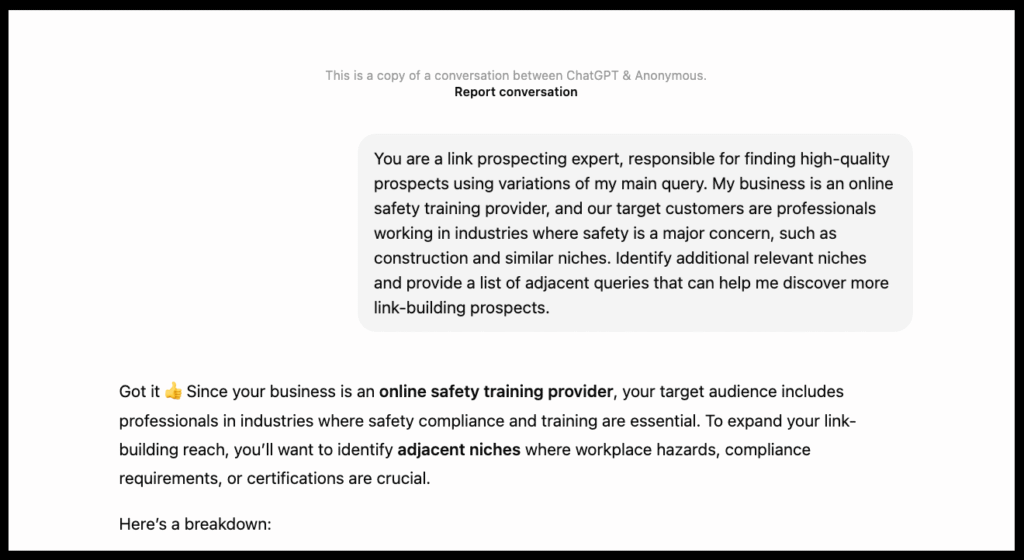
And here’s what we got: a list of high-priority and secondary niches to consider for backlink outreach.
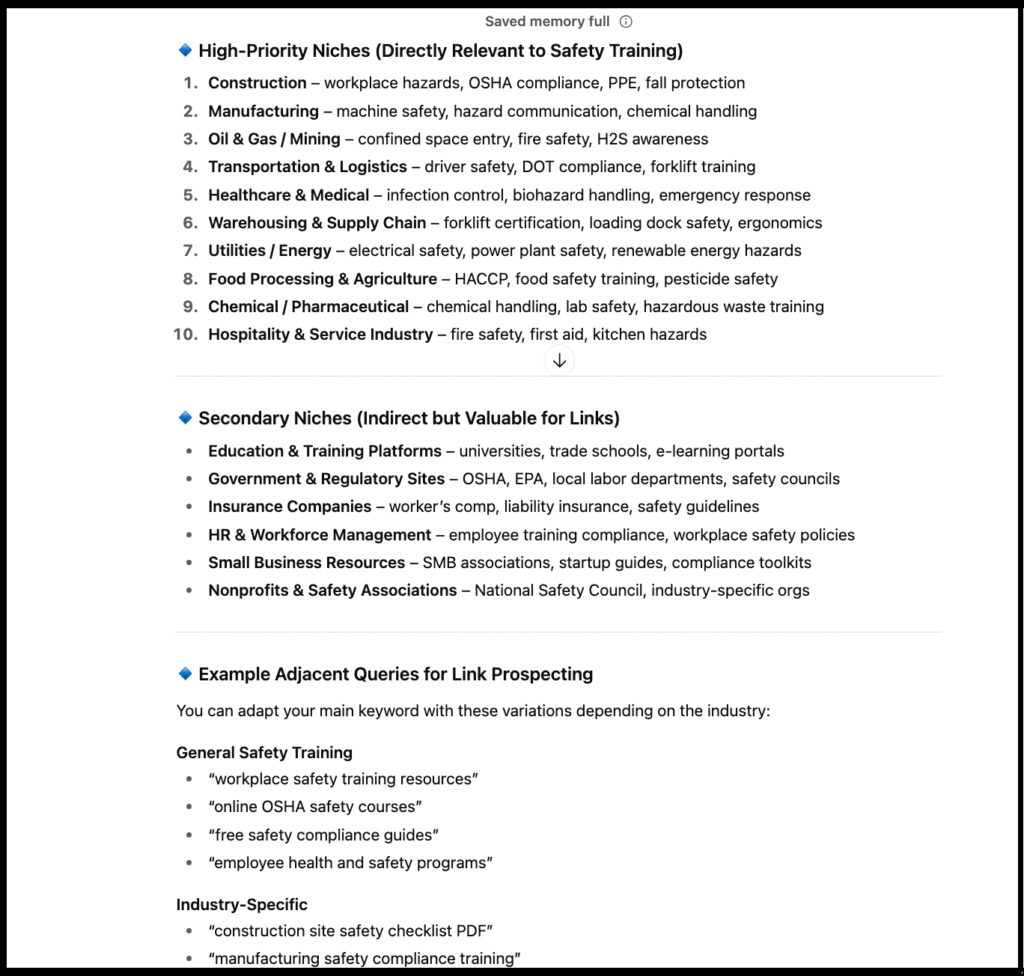
We then asked ChatGPT to:
“Expand on these queries more to identify very specific topics about safety training.”
The result was a list of granular subtopics across industries—far beyond what we could have generated by brainstorming keywords alone.
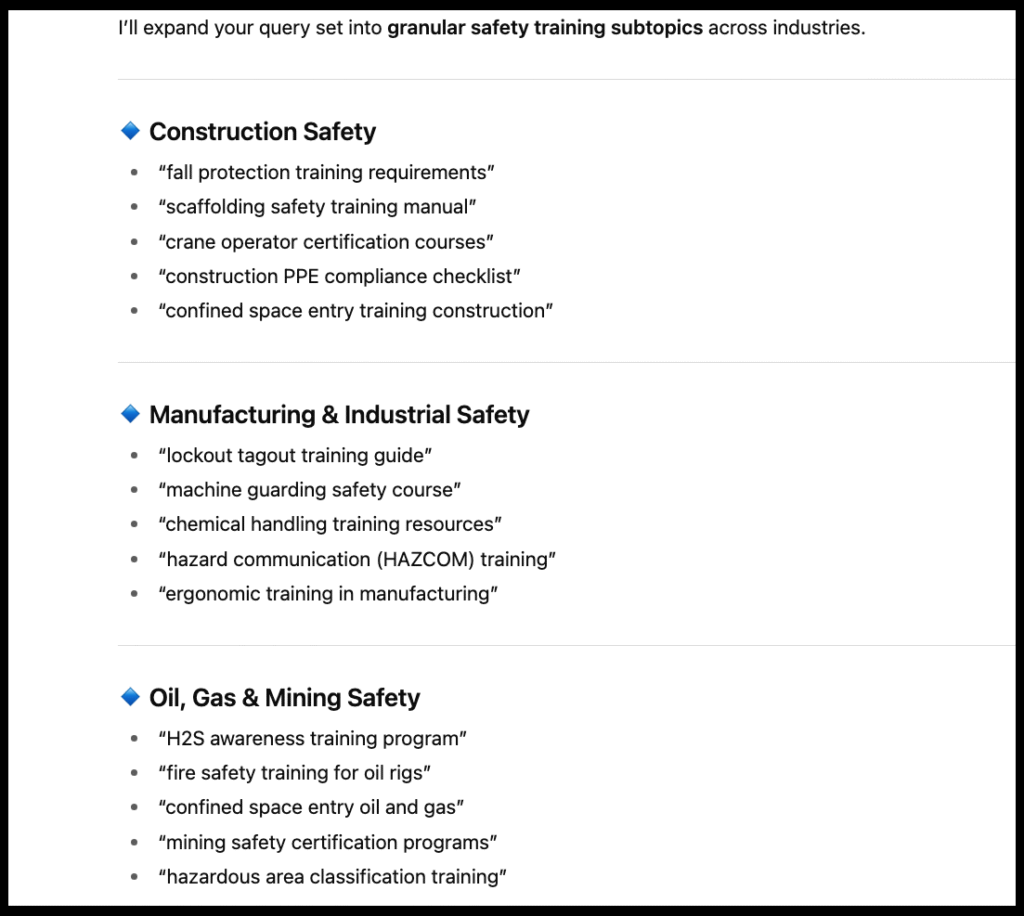
This approach helps you move past traditional keyword research and uncover new avenues for link acquisition.
You can apply this strategy to any industry. Just plug in your business description, product, and target audience into the following prompt and edit as needed:
| “You are a link prospecting expert, responsible for finding high-quality prospects using variations of my main query. My business is an <describe your business><mention industry>, and our target customers are <describe your main ICP>. Identify additional relevant niches and provide a list of adjacent queries that can help me discover more link building prospects.” |
3.2 Other ways to find topical adjacencies
- People Also Ask (PAA): Analyze the People Also Ask section in Google search results to uncover related questions and topics. These can lead you to sites covering subjects adjacent to your niche.

Boost manual link research with People Also Ask section
- AnswerThePublic: This tool visualizes search questions and autocomplete suggestions in a search cloud. It’s a great way to find what people are asking around your keywords, often revealing long-tail, contextually related topics.
| 💡Pro-tip: Semrush study reveals that long-tail keywords make up the vast majority of all Google searches—showing just how much opportunity lies in related but non-obvious queries. |
4. Build relationships in Slack communities
Communities aren’t just for networking—they can also be a goldmine for link opportunities. You’ll find groups across Facebook, LinkedIn, Discord, Slack, and Reddit.
But here’s the catch: not every community is filled with genuine SEO and marketing professionals.
Personally, I’ve had the most success in Slack groups. Of course, the quality depends heavily on the community itself. Some vetted Slack groups worth checking out include:
The key here isn’t just to join but to build rapport. Engage with conversations, share insights, and only then pitch link collaborations. A simple, non-pushy outreach message could look like this:
“Hey, I’m Renu – looking to exchange some indirect links in the Marketing and Health niches. Anyone open to collaborating?”
This approach works because you’re tapping into trusted networks where members are already vetted and actively engaged.
| 💡Pro-tip: Don’t treat communities like a link marketplace. If you consistently contribute value (answer questions, share resources, offer help), people will naturally want to collaborate with you. |
5. Scale with smart automation (without losing personalization)
Automation can supercharge your link prospecting process, but only when paired with thoughtful personalization. The right tools help you scale faster while keeping quality intact.
Here are a few link prospecting tools we recommend:
- Pitchbox: Great for managing outreach campaigns at scale. It automates follow-ups while still inserting personalized snippets so your emails don’t feel templated.
- BuzzStream: Perfect for organizing prospects and tracking conversations. Think of it as your CRM for link building—every contact, email, and response lives in one place.
- Hunter.io: Helps you find and verify professional email addresses, ensuring your outreach lands in the right inbox (and not in spam).
- Respona: Combines prospecting, personalization, and outreach in one platform. Especially handy for pulling in prospects from Ahrefs/Google search and reaching out directly.
The key is to let these tools handle the busywork, such as finding contacts, organizing lists, and scheduling follow-ups. That way, you can focus on the human part: writing messages people actually want to respond to.
| 💡Pro-tip: While doing backlink outreach, use automation to get your foot in the door, but personalization to keep it open. |
4-Step Workflow for Link Prospecting
We’ve covered multiple ways to discover link opportunities. Now let’s turn that into a repeatable workflow—one that helps you separate the signal from the noise and scale your link building efforts without sacrificing quality.
Here’s how we typically run the link prospecting process, step by step:
Step 1: Build your target list
Start by pulling together a spreadsheet of 100–200 potential sites from all the methods we’ve covered—competitor gap analysis, unlinked mentions, topical adjacencies, and community referrals.
Think of this as your raw material: wide enough to catch hidden gems, but not so broad that quality gets diluted.
Step 2: Filter for quality
Not every site makes the cut. This is where manual vetting comes in.
We evaluate each site based on:
- Traffic trends (YoY): Is it stable, or has it been on a steady decline? Avoid sites with a constant downward trend.
- Keyword relevance: Dig deeper into their top organic keywords. If the keywords align with your industry (say, a CRM tool ranking for “lead management” and “cold calls”), it’s a good sign.
- Traffic distribution: Check how traffic is distributed across pages. A site getting 90% of traffic from one blog post or a single page is risky; we want more balance across multiple pages.
This ensures link equity is genuine and sustainable.
Take this example: the site checks all our boxes for link prospecting, including stable traffic, solid DR, balanced backlink profile, and rankings on relevant keywords.
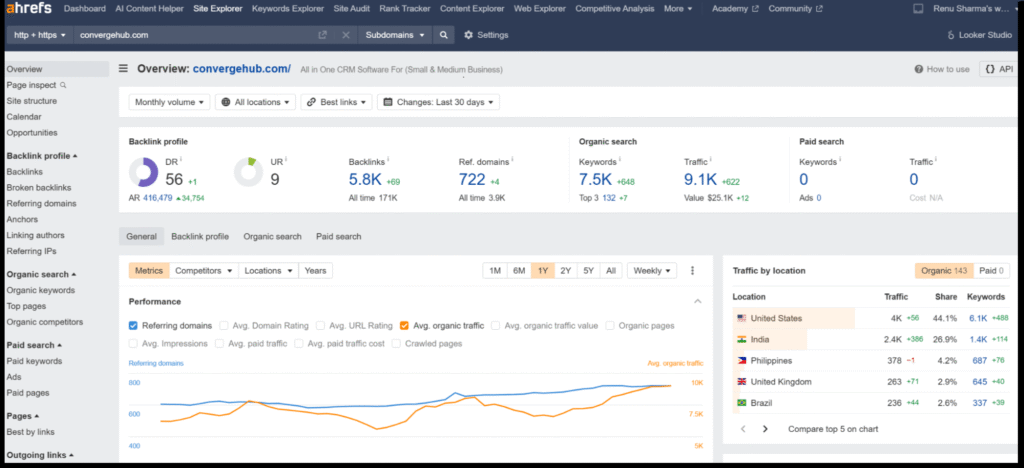
How to find link prospects with smart filters using the Ahrefs tool
Step 3: Identify the right contact
Even the best list won’t work if you’re reaching out to the wrong people. We usually target:
- SEO managers or executives
- Digital marketing leads or heads of marketing
- Content editors or content managers
For smaller companies without dedicated teams, founders or CEOs are worth a shot (though response rates vary).
Use LinkedIn to identify the right people, then use tools like Apollo.io or SalesQL to find verified emails.
Here’s an example layout of a well-structured spreadsheet for link prospecting.

Streamline your backlink outreach with this easy-to-use template
Step 4: Run your backlink outreach sequence
Now that you have a polished list and the right contacts ready, the final piece of the puzzle is outreach.
A simple three-step sequence works best: start with a personalized pitch, follow up gently, and close with a final “value-add” email where you share something useful.
When writing emails, keep these principles in mind:
- Subject line: Short, clear, and intriguing—enough to get the open.
- Copy: Keep it short and crisp; no one wants to read an essay.
- Personalization: Mention something specific about the site, article, or person to show it’s not a mass email.
- Value: Frame the link as a win-win, whether it’s added context, updated data, or resource enrichment.
- Clear CTA: End with a simple, direct ask (e.g., “Would you be open to adding this as a resource?”).
For inspiration, here’s a list of link building outreach templates with tested conversion rates. Use them as a base and customize for your outreach campaigns.
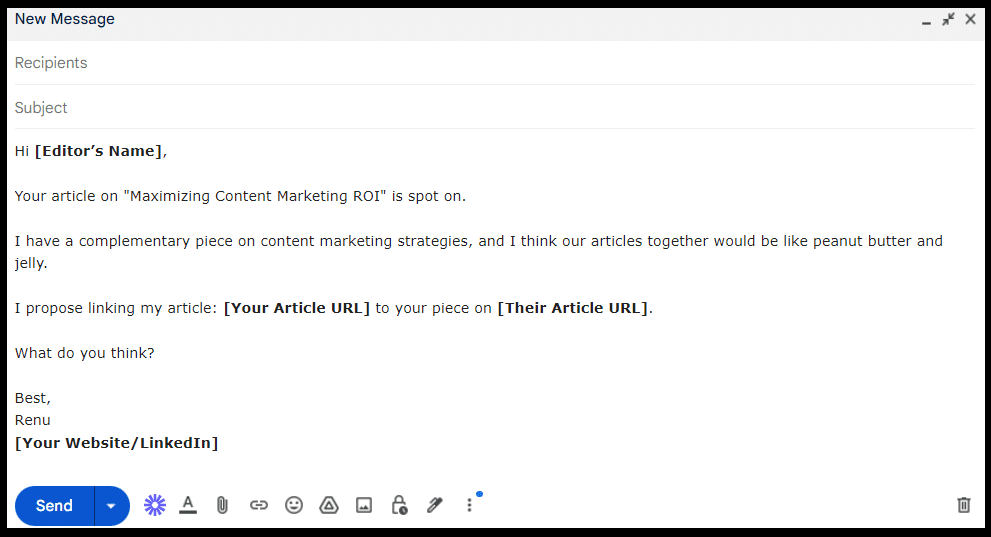
| 💡 Pro-tip: Treat your spreadsheet like a mini-CRM. Track replies, update status, and nurture warm leads—link building is as much about relationships as it is about links. |
Beyond the Link Prospecting Playbook: Your Next Step
Advanced link prospecting isn’t about chasing vanity metrics—it’s about building sustainable rankings, brand authority, and referral traffic. As Google doubles down on E-E-A-T, only contextually relevant, editorial links will matter.
Yes, you can try these link prospecting strategies yourself. But doing it well requires expertise, consistency, and strong relationships. That’s where Tanot Solutions comes in.
- We’ve delivered 5,000+ high-authority links across niches like SaaS, education, health, and law.
- Our vetted partner network spans multiple industries, helping clients secure faster, more reliable results.
- Every link we secure follows the same advanced prospecting methods outlined here.
It’s time to level up your link building workflow. Reach out to Tanot Solutions today, and let’s build links that actually move the needle.
Frequently Asked Questions (FAQs)
1. How can I tell if a backlink is helping my website?
You can tell a backlink is helping if your site starts to rank higher on Google or gets more visits from search engines. Use tools like Google Search Console or Ahrefs to track which pages are getting traffic and where that traffic is coming from. If you see growth after getting a link, it’s likely helping.
2. What makes a backlink good or bad for SEO?
A good backlink comes from a website that talks about the same or similar topics as your own. It should be added in the middle of useful content, not in a long list of links. A bad backlink might come from a spammy or unrelated site. These can do more harm than good, especially if the site has a bad reputation.
3. Is link prospecting still important after Google’s updates?
Yes, it’s still very important. Google wants to show useful and trusted websites in search results. If your site gets links from other trusted websites in your field, it shows Google that your content is helpful. This can improve your rankings and make it easier for people to find your site.
4. What is the difference between link prospecting and link building?
Link prospecting is when you look for websites that might be willing to link to your content. Link building is the next step it’s where you contact those sites, build a relationship, and ask for the link. Both are important, but prospecting is where everything starts. Without it, you won’t find the right sites.
5. How many backlinks do I need to rank higher on Google?
There’s no exact number that works for every site. It depends on your topic, how strong your competitors are, and how good your content is. In many cases, a few strong and relevant backlinks from trusted websites can help more than getting lots of weak or unrelated ones. Focus on quality, not just numbers.
6. Where can I find new backlink opportunities most people miss?
You can find hidden link opportunities in online groups, small niche blogs, or sites that already mention your brand but didn’t add a link. Another way is to search for your images that others have used without credit. These are often easy chances to ask for a backlink and grow your site’s authority.




